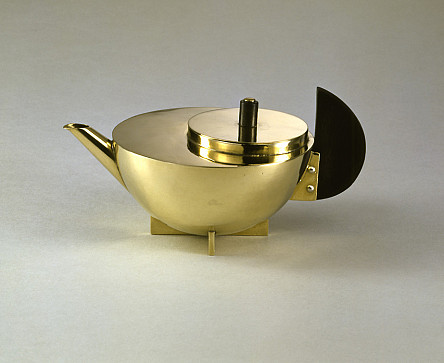
Marianne Brandt, Tea infuser (MT 49), 1924 Bauhaus-Archiv Berlin, Photo: Gunter Lepkowski © VG Bild-Kunst Bonn
Sphere, circle and cross: this is one of the best-known works produced at the Bauhaus.
Marianne Brandt already created this tea infuser at the end of her first year of studies in the Metals Workshop. In programmatic terms, it is constructed from elementary shapes typical of the Weimar period: the body of the vessel consists of a hemisphere, and the handle is a segment of a circle. Instead of the traditional ringed base, it sits on a cross, which emphasizes the pot’s main axes and also gives it a certain quality of weightlessness.
The pot, only 7.5 cm high, thus looks like a sculptural implementation of compositions by László Moholy-Nagy, who headed the Metals Workshop at the Bauhaus from 1923 to 1928. His aim was to make the former ‘Gold-, Silver- and Coppersmiths’ Workshop’ more industrial and he was open to materials such as nickel and glass, which did not traditionally belong in the field. This made possible, for example, the creation of the legendary Bauhaus Lamp by Carl Jakob Jucker and Wilhelm Wagenfeld. Like several other products of the Weimar period, however, it was to remain an expensive hand-made item. In Dessau, the Metals Workshop then became a regular design laboratory for new lighting fixtures. After several lamp manufacturers had put the models into serial production, the Metals Workshop ultimately became one of the most productive and successful workshops at the Bauhaus.